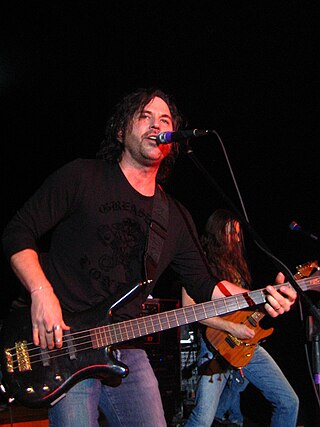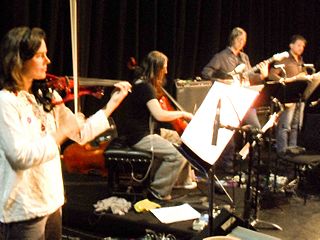Related Research Articles
Michael Torke is an American composer who writes music influenced by jazz and minimalism.

New York City Ballet (NYCB) is a ballet company founded in 1948 by choreographer George Balanchine and Lincoln Kirstein. Balanchine and Jerome Robbins are considered the founding choreographers of the company. Léon Barzin was the company's first music director. City Ballet grew out of earlier troupes: the Producing Company of the School of American Ballet, 1934; the American Ballet, 1935, and Ballet Caravan, 1936, which merged into American Ballet Caravan, 1941; and directly from the Ballet Society, 1946.

Charles Frederick Winger is an American singer and bass guitarist, active as a member of the rock band Winger and as a solo artist. He initially gained notability as a member of Alice Cooper's band, contributing bass to his Constrictor (1986) and Raise Your Fist and Yell (1987) albums.

Romeo and Juliet, Op. 64, is a ballet by Sergei Prokofiev based on William Shakespeare's play Romeo and Juliet. First composed in 1935, it was substantially revised for its Soviet premiere in early 1940. Prokofiev made from the ballet three orchestral suites and a suite for solo piano.
Ib Andersen is a Danish ballet dancer and choreographer. He was principal dancer for the Royal Danish Ballet 1975-1980, for the New York City Ballet 1980-1990, freelancing ballet master 1990-2000 and artistic director of Ballet Arizona 2000-2024.

Icebreaker is a UK-based new music ensemble founded by James Poke and John Godfrey. They interpret new music, specialising in a post-minimal and "totalist" repertoire. Icebreaker always play amplified and have a reputation for playing, by classical standards, "seriously loud". They have expanded their repertoire to include non-classical material, particularly in their version of the Brian Eno album Apollo, a project based on the music of Kraftwerk, and music by Scott Walker.

Rudi van Dantzig was a Dutch choreographer, company director, and writer. He was a pivotal figure in the rise to world renown of Dutch ballet in the latter half of the twentieth century.

Stars and Stripes is a neoclassical ballet choreographed by George Balanchine to music by John Philip Sousa, orchestrated by Hershy Kay. The ballet was made as a tribute to the United States, Balanchine's adopted country. It premiered on January 17, 1958, at the City Center of Music and Drama, danced by the New York City Ballet. It is dedicated to Fiorello La Guardia, former mayor of New York City. The ballet had been revived by multiple ballet companies, and at different special occasions.
Black and White is a ballet made by New York City Ballet ballet master, subsequently ballet master in chief, Peter Martins to some of Michael Torke's eponymous music which was commissioned for City Ballet's American Music Festival; the premiere took place on 7 May 1988 at the New York State Theater, Lincoln Center. Black and White was the second in a series of collaborations between the choreographer and composer.
Ash is a ballet made by New York City Ballet's ballet master in chief Peter Martins to Ash (1991) by Michael Torke. The premiere took place Thursday, June 20, 1991, at the New York State Theater, Lincoln Center. Ash was the fourth in a series of collaborations between the choreographer and composer.
Sean Lavery was a former principal dancer, balletmaster, and assistant to the balletmaster in chief at New York City Ballet. He was a répétiteur for the George Balanchine Trust and a former faculty member at the School of American Ballet.

Grete Wiesenthal was an Austrian dancer, actor, choreographer, and dance teacher. She transformed the Viennese Waltz from a staple of the ballroom into a wildly ecstatic dance. She was trained at the Vienna Court Opera, but left to develop her own more expressive approach, creating ballets to music by Franz Schreker, Clemens von Franckenstein, and Franz Salmhofer, as well as dancing in her own style to the waltzes of Johann Strauss II. She is considered a leading figure in modern dance in Austria.
Mozartiana is a ballet choreographed by George Balanchine to Tchaikovsky's Orchestral Suite No. 4, Mozartiana. The current version of the ballet was made for New York City Ballet's Tchaikovsky Festival, and premiered on June 4, 1981, at the New York State Theater. It is considered Balanchine's last major work.
Echo is a ballet made by New York City Ballet ballet master Peter Martins to Michael Torke's Slate (1989). The premiere took place on 15 June 1989 at the New York State Theater, Lincoln Center. Echo was the third in a series of collaborations between the choreographer and composer.
Peter Frame was an American ballet dancer and dance teacher. He danced with New York City Ballet from 1976 until 1990 and was elevated to the rank of principal dancer in 1988. He was a faculty member at the School of American Ballet from 1993 until his death in 2018.
Ivesiana is a ballet choreographed by George Balanchine to compositions by Charles Ives. The ballet premiered on September 14, 1954, four months after Ives's death, at the City Center of Music and Drama, performed by the New York City Ballet. Balanchine made several changes to the ballet since, including adding and removing sections of the ballet, and the final version of Ivesiana consists of Central Park in the Dark, The Unanswered Question, In the Inn and In the Night.

Billboards is a ballet commissioned by Gerald Arpino for the Joffrey Ballet featuring the works of Prince. The premiere was on Wednesday, January 27, 1993, at Hancher Auditorium, University of Iowa, Iowa City.
Color Music is a suite of five different compositions for orchestra by American composer Michael Torke. The suite is well known for its association with the composer's synesthesia.
Duo Concertant is a ballet choreographed by George Balanchine to Stravinsky's score of the same name. The ballet was created for New York City Ballet's Stravinsky Festival, a tribute to the composer a year after his death, and premiered on June 22, 1972, at the New York State Theater, danced by Kay Mazzo and Peter Martins.
References
- Playbill , New York City Ballet, Friday, June 27, 2008